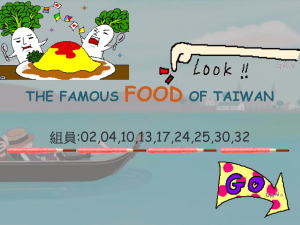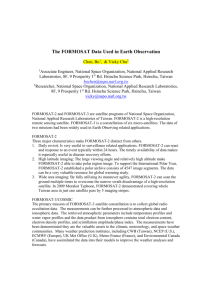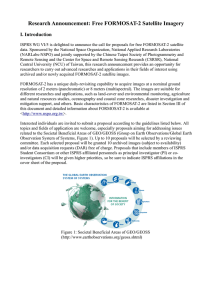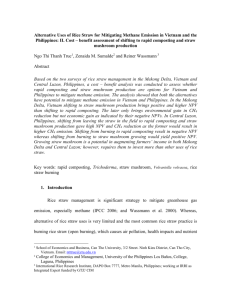Estimating the carbon dioxide emitted from rice
advertisement
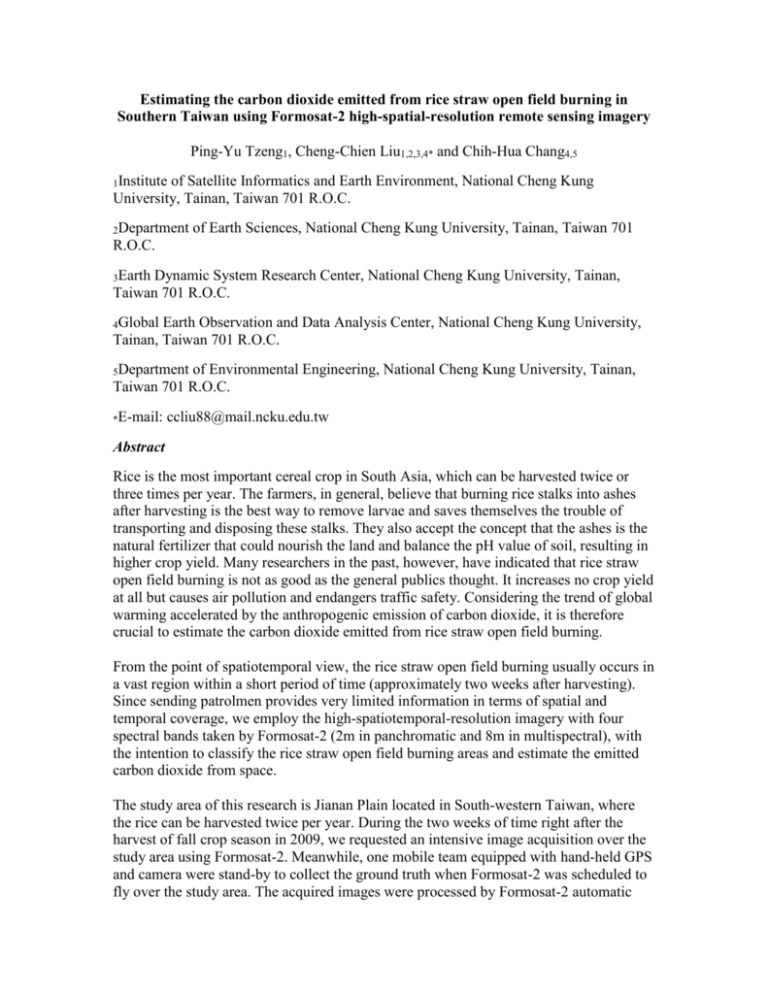
Estimating the carbon dioxide emitted from rice straw open field burning in Southern Taiwan using Formosat-2 high-spatial-resolution remote sensing imagery Ping-Yu Tzeng1, Cheng-Chien Liu1,2,3,4* and Chih-Hua Chang4,5 1Institute of Satellite Informatics and Earth Environment, National Cheng Kung University, Tainan, Taiwan 701 R.O.C. 2Department of Earth Sciences, National Cheng Kung University, Tainan, Taiwan 701 R.O.C. 3Earth Dynamic System Research Center, National Cheng Kung University, Tainan, Taiwan 701 R.O.C. 4Global Earth Observation and Data Analysis Center, National Cheng Kung University, Tainan, Taiwan 701 R.O.C. 5Department of Environmental Engineering, National Cheng Kung University, Tainan, Taiwan 701 R.O.C. *E-mail: ccliu88@mail.ncku.edu.tw Abstract Rice is the most important cereal crop in South Asia, which can be harvested twice or three times per year. The farmers, in general, believe that burning rice stalks into ashes after harvesting is the best way to remove larvae and saves themselves the trouble of transporting and disposing these stalks. They also accept the concept that the ashes is the natural fertilizer that could nourish the land and balance the pH value of soil, resulting in higher crop yield. Many researchers in the past, however, have indicated that rice straw open field burning is not as good as the general publics thought. It increases no crop yield at all but causes air pollution and endangers traffic safety. Considering the trend of global warming accelerated by the anthropogenic emission of carbon dioxide, it is therefore crucial to estimate the carbon dioxide emitted from rice straw open field burning. From the point of spatiotemporal view, the rice straw open field burning usually occurs in a vast region within a short period of time (approximately two weeks after harvesting). Since sending patrolmen provides very limited information in terms of spatial and temporal coverage, we employ the high-spatiotemporal-resolution imagery with four spectral bands taken by Formosat-2 (2m in panchromatic and 8m in multispectral), with the intention to classify the rice straw open field burning areas and estimate the emitted carbon dioxide from space. The study area of this research is Jianan Plain located in South-western Taiwan, where the rice can be harvested twice per year. During the two weeks of time right after the harvest of fall crop season in 2009, we requested an intensive image acquisition over the study area using Formosat-2. Meanwhile, one mobile team equipped with hand-held GPS and camera were stand-by to collect the ground truth when Formosat-2 was scheduled to fly over the study area. The acquired images were processed by Formosat-2 automatic image processing system as described by Liu (2006). Based on the training areas identified by the mobile team, the supervised classification was carried out using the maximum likelihood method on both before- and after-harvesting images. To improve the accuracy of classification, the land-use map published by the Ministry of the Interior was referred to mask out the non-agricultural areas, such as buildings, roads, etc. The isolated and spurious pixels were removed or combined by using the block divided region of high homogeneity. Comparing to the ground truths collected by the mobile team, both the users and producers accuracies for the classified burned rice paddy are as high as 90%. The total emitted carbon dioxide was estimated by multiplying the total area with the published conversion factor. The results show that a total of 130,000 tons of carbon dioxide are emitted from rice straw open field burning in Taiwan every year. The per capita accumulated carbon dioxide emission for Taiwan is 12.08 ton, ranking top twenty of the world. In other words, stopping rice straw open field burning in Taiwan would cut off more than ten thousand times of per capita accumulated carbon dioxide emission. Since the situation is similar in other South Asia countries and the other sources of carbon dioxide are usually very difficult to cut off, stopping the rice straw open field burning seems to be the easiest and the quickest way to reduce the anthropogenic carbon dioxide emission and hence would decelerate the trend of global warming.



